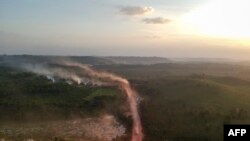New satellite images published Monday by the European Space Agency show an increase in air pollution in the Brazilian Amazon while fires burned in the region last month.
Several maps showed more carbon monoxide and other pollutants in August than in the previous month, when there were fewer fires.
The agency said fires released carbon dioxide once stored in the Amazon forests back into the atmosphere, potentially having an impact on the global climate and health.
Burning continues in the Amazon despite a 60-day ban on land-clearing fires that was announced last month by President Jair Bolsonaro.
Data from Brazil's National Institute for Space Research showed the number of fires in all of Brazil has surpassed 100,000 so far this year, up 45 percent compared to the same period in 2018.
Renata Libonati, a professor in the department of meteorology at the Rio de Janeiro Federal University, said that aside from gases, the burning of forests also released particles into the atmosphere.
Health experts say studies show that air pollution, whether it is small particles or gases, leads to an increase in cardiovascular conditions and lung problems, especially among young children and the elderly.
In Porto Velho, the capital of Brazil's Amazon state of Rondonia, lingering smoke has reportedly caused an increase in such respiratory problems. The number of people treated for respiratory issues increased sharply in August at the Cosme e Damia Children's hospital.
But small particles can also be transported by winds in cities that are not immediately close to where the fires are taking place.
"The impact of the fires goes far beyond where the forests are burning," Libonati told The Associated Press.
The lack of rain during the current dry season in the Amazon region makes things worse, she said, as rain can help stop the progress of particle pollution.
Brazil's Health Ministry shared last week a list of recommendations for those living in areas close to the fires, saying people should "avoid staying near places where the fires are happening," wear masks and eye protection outdoors and favor air conditioning, especially in kindergartens, schools and hospitals.
Last month, Bolsonaro sent the army to help combat the fires. A team of 11 Israeli firefighters was also deployed Sunday in the state of Rondonia to help state and federal forces, the defense ministry said in a statement.
Meanwhile, in the Amazonian state of Para, about 250 illegal miners, known as "garimpeiros," blocked a federal highway Monday demanding that the government legalize mining activities, the newspaper Folha de S. Paulo reported.
The group, working for wildcat mines in the region, also asked for an end to on-the-ground operations by environmental protection bodies that have the authority to burn equipment allegedly belonging to illegal miners.









